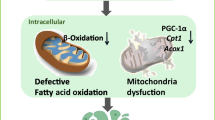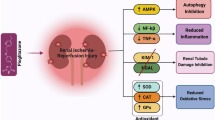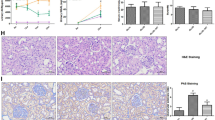Abstract
Background
Peritoneal fibrosis (PF) is caused by epithelial-mesenchymal transdifferentiation (EMT) in the peritoneum under high glucose (HG) conditions. The study aimed to explored the role of Insulin-like growth factor 1 receptor (IGF-1R) in the regulation of EMT in human peritoneal mesothelial cells (HPMCs).
Methods
We used HG peritoneal dialysis fluid (PDF) to induce in vivo PF in mice, and treated HPMCs with HG in vitro to stimulate EMT.
Results
In the mice, the higher the glucose concentration in the dialysate, the more obvious the peritoneal tissue thickening and the more that collagen was deposited. The in vitro study indicated that the expression of IGF-1R, α-SMA, vimentin was upregulated, while the expression of occludin, ZO-1, and E-cadherin was downregulated in HPMCs under HG and IGF-1R overexpression conditions. Conversely, the expression of IGF-1R, α-SMA, and vimentin was downregulated, while the expression of occludin, ZO-1, and E-cadherin was upregulated in IGF-1R-underexpressed HPMCs under HG conditions. The cell migration abilities were increased, while the cell adhesion abilities were reduced in HPMCs under HG and IGF-1R overexpression conditions. In contrast, cell migration abilities were reduced, while cell adhesion abilities were increased in IGF-1Runderexpressed HPMCs under HG conditions.
Conclusions
Targeting at IGF-1R may provide novel insights into the prevention and treatment of PF.







Similar content being viewed by others
References
Mehrotra R, Devuyst O, Davies SJ, Johnson DW. The current state of peritoneal dialysis. J Am Soc Nephrol. 2016;27:3238–52.
Williams JD, Craig KJ, Topley N, Von Ruhland C, Fallon M, et al. Morphologic changes in the peritoneal membrane of patients with renal disease. J Am Soc Nephrol. 2002;13:470–9.
Weber CE, Li NY, Wai PY, Kuo PC. Epithelial-mesenchymal transition, tgf-beta, and osteopontin in wound healing and tissue remodeling after injury. J Burn Care Res. 2012;33:311–8.
Aroeira LS, Aguilera A, Sanchez-Tomero JA, Bajo MA, Del PG, et al. Epithelial to mesenchymal transition and peritoneal membrane failure in peritoneal dialysis patients: pathologic significance and potential therapeutic interventions. J Am Soc Nephrol. 2007;18:2004–13.
Thiery JP, Acloque H, Huang RY, et al. Epithelial-mesenchymal transitions in development and disease. Cell. 2009;139:871–90.
Zeisberg M, Neilson EG. Biomarkers for epithelial–mesenchymal transitions. J Clin Invest. 2009;119:1429–37.
Yu MA, Shin KS, Kim JH, Kim YI, Chung SS, et al. Hgf and bmp-7 ameliorate high glucose-induced epithelial-to-mesenchymal transition of peritoneal mesothelium. J Am Soc Nephrol. 2009;20:567–81.
Delafontaine P. Insulin-like growth factor I and its binding proteins in the cardiovascular system. Cardiovasc Res. 1995;30:825–34.
LeRoith D, Werner H, Beitner-Johnson D, Roberts CT Jr. Molecular and cellular aspects of the insulin-like growth factor I receptor. Endocr Rev. 1995;16:143–63.
van der Wal BC, Hofland LJ, Marquet RL, van Koetsveld PM, et al. Paracrine interactions between mesothelial and colon-carcinoma cells in a rat model. Int J Cancer. 1997;73:885–90.
Delafontaine P, Song Y-H, Expression YL. Regulation, and function of IGF-1, IGF-1R, and IGF-1 binding proteins in blood vessels. Arterioscler Thromb Vasc Biol. 2004;24:435–44.
Chu PC, Lin PC, Wu HY, et al. Mutant KRAS promotes liver metastasis of colorectal cancer, in part, by upregulating the MEK-Sp1-DNMT1-miR-137-YB-1-IGF-IR signaling pathway. Oncogene. 2018;37(25):3440–55.
Numata K, Oshima T, Sakamaki K, et al. Clinical significance of IGF1R gene expression in patients with stage ii/iii gastric cancer who receive curative surgery and adjuvant chemotherapy with s-1. J Cancer Res Clin Oncol. 2016;142:415–22.
Su C, Wang W, Wang C. IGF-1-induced MMP-11 expression promotes the proliferation and invasion of gastric cancer cells through the JAK1/STAT3 signaling pathway. Oncol Lett. 2018;15:7000–6.
Robertson DM, Zhu M, Wu YC. Cellular distribution of the IGF-1R in corneal epithelial cells. Exp Eye Res. 2012;94:179–86.
Cox OT, O’Shea S, Tresse E, Bustamante-Garrido M, et al. IGF-1 receptor and adhesion signaling: an important axis in determining cancer cell phenotype and therapy resistance. Front Endocrinol (Lausanne). 2015;3(6):106.
Peinado H, Olmeda D, Cano A. Snail, Zeb and bHLH factors in tumour progression: an alliance against the epithelial phenotype? Nat Rev Cancer. 2007;7(6):415–28.
Vega S, Morales AV, Ocana OH, Valdes F, Fabregat I, et al. Snail blocks the cell cycle and confers resistance to cell death. Genes Dev. 2004;18:1131–43.
Liu J, Jiang C-M, Feng Y, Zhu W, et al. Rapamycin inhibits peritoneal fibrosis by modifying lipid homeostasis in the peritoneum. Am J Transl Res. 2019;11(3):1473–85.
Hung K-Y, Huang J-W, Chiang C-K, Tsai T-J. Preservation of peritoneal morphology and function by pentoxifyllinein a rat model of peritoneal dialysis: molecular studies. Nephrol Dial Transpl. 2008;23:3831–40.
Ishibashi Y, Sugimoto T, Ichikawa Y, et al. Glucose dialysate induces mitochondrial DNA damage in peritoneal mesothelial cells. Perit Dial Int. 2002;22(1):11–21.
Pollock C. Pathogenesis of peritoneal sclerosis. Int J Artif Org. 2005;28(2):90–6.
Liu Y, Dong Z, Liu H, Zhu J, Liu F, Chen G. Transition of mesothelial cell to fibroblast in peritoneal dialysis: EMT, stem cell or bystander? Peritoneal Dial Int J Int Soc Peritoneal Dial. 2015;35:14–25.
Shin HS, Ryu ES, Oh ES, Kang DH. Endoplasmic reticulum stress as a novel target to ameliorate epithelial-to-mesenchymal transition and apoptosis of human peritoneal mesothelial cells. Lab Investig. 2015;95:1157–73.
Zheng Z, Ye R, Yu X, et al. Peritoneal dialysis solutions disturb the balance of apoptosis and proliferation of peritoneal cells in chronic dialysis model. Adv Perit Dial. 2001;17:53–7.
Tulchinsky E, Demidov O, Kriajevska M, Barlev NA, Imyanitov E. EMT: A mechanism for escape from EGFR-targeted therapy in lung cancer. Biochim Biophys Acta Rev Cancer. 2019;1871(1):29–39.
Baxter RC. The insulin-like growth factors and their binding proteins. Comp Biochem Physiol B. 1988;91(2):229–35.
Malaguarnera R, Frasca F, Garozzo A, Giani F, Pandini G, Vella V, et al. Insulin receptor isoforms and insulin-like growth factor receptor in human follicular cell precursors from papillary thyroid cancer and normal thyroid. J Clin Endocrinol Metab. 2011;96:766–74.
Chen WJ, Ho CC, Chang YL, Chen HY, Lin CA, Ling TY, et al. Cancer-associated fibroblasts regulate the plasticity of lung cancer stemness via paracrine signalling. Nat Commun. 2014;5:3472.
Kim IG, Kim SY, Choi SI, Lee JH, Kim KC, Cho EW. Fibulin-3-mediated inhibition of epithelial-to-mesenchymal transition and self-renewal of ALDH+lung cancer stem cells through IGF-1R signaling. Oncogene. 2014;33:3908–17.
Acknowledgements
This work was supported by the General Project of Nan**g Medical Science and Technology Development (YKK19057).
Author information
Authors and Affiliations
Corresponding authors
Ethics declarations
Conflicts of interest
None.
Additional information
Publisher's Note
Springer Nature remains neutral with regard to jurisdictional claims in published maps and institutional affiliations.
About this article
Cite this article
**a, Y., Wan, C., Zhang, Q. et al. Role of IGF-1R in epithelial–mesenchymal transdifferentiation of human peritoneal mesothelial cells. Clin Exp Nephrol 26, 630–639 (2022). https://doi.org/10.1007/s10157-022-02209-w
Received:
Accepted:
Published:
Issue Date:
DOI: https://doi.org/10.1007/s10157-022-02209-w




